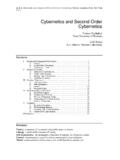Transcription of CHROMISTA REVISITED: A DILEMMA OF …
1 Phytologia (August 2009) 91(2) 191 CHROMISTA REVISITED: A DILEMMA OF overlapping putative KINGDOMS, AND THE attempted APPLICATION OF THE botanical CODE OF NOMENCLATURE Will H. Blackwell Biological Sciences, The University of Alabama, Tuscaloosa, AL 35487, USA ABSTRACT It was many centuries before it was realized that all organisms were not either plants or animals, and many more years before it was understood that the catch-all kingdom Protista proposed to include predominantly unicellular, non-plants and non-animals was heterogeneous and phylogenetically inadequate, encompassing both related and unrelated organisms. The probable unity of a particular group of protists viewed as chromophytous algae or pseudofungi (and related protozoal forms), and often exhibiting a characteristic heterodynamic flagellar pattern was gradually understood; these became separated from Protista, and recognized by various kingdom , subkingdom, phylum, or subphylum names.
2 At kingdom level, two names and groupings CHROMISTA and Stramenopiles have competed, among others, for these typically heterokont protists, in a partial overlay of descriptive information. Stramenopiles have the tighter circumscription, by virtue of definition based on the occurrence of unique, composite, tubular, flagellar hairs. Acceptance of Stramenopiles (as a more clearly monophyletic group) was beginning to hold sway over the more diverse CHROMISTA (with its less obviously related major sub-groupings). However, recent evidence from plastid evolution has suggested that the larger, yet still generally monophyletic, assemblage of (mostly) heterokont protists the CHROMISTA remains viable as a putative kingdom , much in the original sense of Cavalier-Smith (1981, 1986). Although the matter is still equivocal, the present paper notes a return to usage of the kingdom name CHROMISTA representing an assemblage including not only stramenopilous organisms, but also plastid-related groups, , haptophytes and cryptomonads.
3 The naming of chromistans has fallen by tradition mainly under the botanical code of nomenclature, which, as the other Phytologia (August 2009) 91(2) 192major eukaryotic code (the zoological code), contains little regulation at kingdom level. Difficulty in properly establishing kingdoms, such as CHROMISTA , or Straminipila, might be alleviated if a unified code of (biological) nomenclature were developed, with guidelines for determining/composing kingdom names. As a further point of present code deficiency, supra- kingdom ranks (to which yet larger groupings such as Chromalveolata might be assigned) are not recognized in existing, formal codes ( botanical , zoological, or bacteriological) a situation that could also be changed through code unification. It is important to examine current, proposed, ad hoc naming schemes in context of present nomenclatural codes (one of the points of this paper).
4 It would be gratifying if systematists that produce future encompassing taxonomies (major eukaryotic schemata), and those involved with the development of a future code (or codes) of nomenclature, could work in consort toward the goal of improved, stabile systems of classification systems not only modern and biologically accurate, but nomenclaturally appurtenant as well. Phytologia 91(2): 191-225 (August, 2009). KEY WORDS: Chromalveolata, CHROMISTA , codes of nomenclature, code unification, complex plastids, Domain, endosymbiosis, heterodynamic flagella, Heterokonta, holophyletic, kingdom , monophyletic, Ochrista, Pseudofungi, Stramenopila, Straminipila, supergroup, Supra- kingdom , tubular mastigonemes, tubular mitochondrial cristae. botanical nomenclatural regulation is lax at ranks above Family, especially for names not automatically typified consider Articles 16 and 17, International Code of botanical Nomenclature (ICBN), McNeill et al.
5 (2006). Nomenclature at these higher levels can be confusing. At the rank of Class, three different terminations for names are suggested (Recommendation , ICBN), depending on the kind of plant in question. This can result in rather closely related plant groups , liverworts, compared with their probable relatives, the charophytes (cf. Niklas, 1997; Blackwell, 2003) having quite different sounding Class names. At Division/Phylum level, although name-terminations are reduced to two ( , for plants vs. fungi ), the dual usage in botany now , Division or Phylum (Recommendation ) is in itself confusing. At kingdom level, Phytologia (August 2009) 91(2) 193there are essentially no Code instructions on how to name these major groups. There are, for example, no guidelines for kingdom name terminations. By convention, such names often end in a , Animalia, Archaebacteria, Biliphyta, Monera but this is not uniformly followed, , Fungi, Plantae, Viridiplantae.
6 Jeffrey (1971) proposed that the suffix -biota, implying neither plant, nor animal, nor fungus (nor bacterium, for that matter), be used as a standard, neutral ending for kingdom names; however, this proposal was not widely adopted. There is, in fact, a paucity of nomenclatural regulation by the botanical code and (particularly) by the zoological code of higher categories such as Phylum (Division), Class, and even Order. In the case of the botanical code, such weak regulation has been attributed to the belief that these upper groups are too unstable or uncertain in delimitation (cf. Gledhill, 1989) for application of rigorous nomenclature such as the principle of priority, or the type method (with the exception of automatically typified names, cf. Article , ICBN, 2006; but even this does not clearly apply to kingdom ). The dearth of rules and recommendations at the level of kingdom , however, is perhaps more of an historical artifact.
7 Until the mid-nineteenth century, it was believed that there were just plant and animal kingdoms hence, no need for detailed regulation of names of kingdoms (because the matter was non-controversial). This changed, though, when authors such as Hogg (1860) and Haeckel (1866) recognized, additionally, a protoctist (or protist ) kingdom for (mostly) unicellular organisms, not clearly plant or animal. While some later authors ( , Copeland, 1956; Whittaker, 1959) continued to emphasize (and increase the recognition of) kingdoms, others ( , Christensen, 1958) came to believe that kingdom was a relatively meaningless, perhaps artificial, grouping category, and recommended removal of Regnum ( kingdom ) from the botanical code. Christensen s proposal (1958) did not gain favor, however, and the ICBN (2006) still recognizes kingdom (Article ) even though specific rules for regulating this category remain absent.
8 By mid-twentieth century, the number of kingdoms generally accepted had risen to five (cf. Whittaker, 1969). More recently, six to nine kingdoms have often been recognized (cf. Edwards, 1976; Cavalier-Smith, 1981, 1987, 1993, 2004; Corliss, 1994; Blackwell and Phytologia (August 2009) 91(2) 194 Powell, 1995, 1999; Blackwell, 2004). With proliferation of kingdoms came the additional complication of the supra- kingdom category, Domain (Woese et al., 1990) a rank not sanctioned by codes of nomenclature. In any case, more kingdoms or kingdom -level groups are presently recognized than there are codes of nomenclature (There are three major organism-based codes, discussed below). Several different kingdoms, or parts of kingdoms, are under the umbrella of the botanical code alone (cf. Blackwell and Powell, 1999; Blackwell, 2008) , Fungi, Myxomycetes (these being Protozoa, cf.)
9 Corliss, 1991), Cyanobacteria, and most Stramenopiles (cf. Blackwell and Powell, 1999) in addition to plants, obviously the intended objects of this code. It may be controversial which code should control the nomenclature of a given group of organisms, , Cyanobacteria in this case, the botanical or the bacteriological code (cf. Blackwell, 2008). So, questions remain: Were the kingdoms that we now recognize properly established, based on both biology and nomenclature? If not, how should they be established? Is it possible to determine if a given kingdom name is technically accurate and properly applied? Is, for example, the kingdom name-termination appropriate? On what basis is this decided? And, under which code of nomenclature should each putative kingdom be governed? Cavalier-Smith (1978) and Corliss (1983) initially raised questions concerning possible nomenclatural consequences of creating multiple kingdoms of organisms, a situation readdressed by Blackwell and Powell (1999), and that pertains here.
10 These sorts of questions do not necessarily have ready answers, nor will I seek to deal with all such questions here (and certainly not for all kingdoms). What I wish to address is a special confusion concerning two proposed kingdoms CHROMISTA and Stramenopila that have similar, yet clearly non-identical, circumscriptions; , they are descriptively over-lapping. I give, subsequently, particular consideration to determination of the usage and best application of these particular names and groupings, and to the various complications that are attendant. Phytologia (August 2009) 91(2) 195 CHROMISTANS, STRAMENOPILES, AND THE botanical CODE The case in point here, CHROMISTA vs. Stramenopiles, is which kingdom and name to recognize? In addressing this question, it should be decided under which code the nomenclature of these groups should fall. Organisms recognized variously as chromistans and stramenopiles are neither plants nor animals (cf.)






